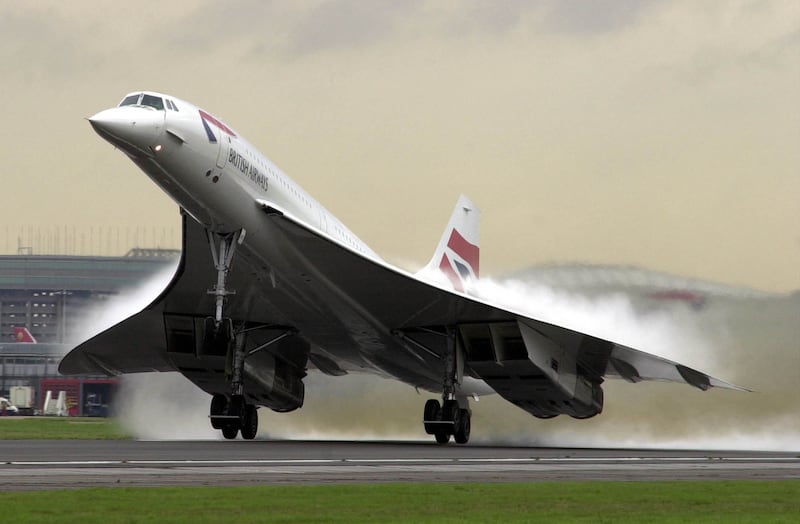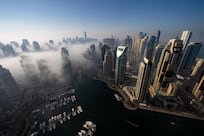Shortly after 4pm on October 24, 2003, British Airways flight 02 from New York touched down at London’s Heathrow Airport. It was the aircraft’s final Atlantic crossing and marked the end of commercial supersonic air travel.
For 27 years, Concorde carried passengers at speeds of Mach 2, or more than 2,100kph. With its dart wings, streamlined shape and iconic drooping nose, it represented the ultimate in aircraft technology and ambition.
Looking back at the BBC report of that final commercial flight 20 years ago, it is easy to see why Concorde’s time was up. The interior is narrow and cramped, the seating almost resembling a budget airline, with barely no recline. Entertainment was restricted to a few music channels and the bathrooms were so small that they were nearly impossible to use.
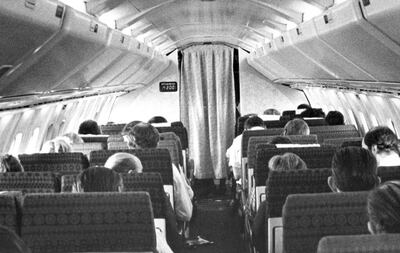
That last passenger list is also instructive. A mixture of ageing celebrities and grey-haired and suited business types, they were the aircraft’s client base, the only ones with a big enough bank balance or expensive account to afford the one-way $8,000 ticket.
In truth, two decades later, Concorde looks more like a blast from the past than the future of air travel.
Despite the glamour of travelling at twice the speed of sound and reaching New York from London in less than three and half hours, the aircraft had a troubled history, never matching the expectations of the French and British governments that conceived it as a joint project.
Orders for up to 350 Concordes from 100 airlines, placed when it was still under construction, dwindled as the cost of operation and oil prices soared in the 1980s.
In the end, only 14 were delivered when the aircraft went into commercial service in January 1976, seven each for the state airlines Air France and BOAC, now British Airways.
This was despite a worldwide sales push. In 1974, Concorde landed at what is now Al Bateen Executive Airport, ostensibly part of hot weather testing but also to drum up potential buyers. It then went on to Dubai.
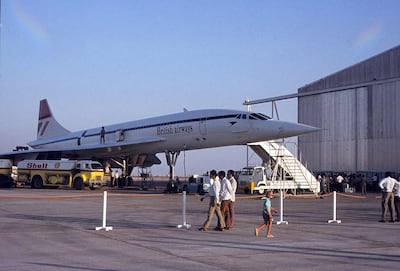
Concerns about noise and pollution – and possibly more than a little protectionism – blocked the introduction of lucrative US routes until 1977. For its first routes, BOAC travelled to Bahrain while Air France headed for Rio de Janeiro in Brazil via Dakar in Senegal.
Blocked from flying overland because of its sonic boom, the aircraft still managed to turn a profit in the 1980s on the New York route, at one point earning British Airways about £30 million to £50 million ($36.5 million to $60.8 million) a year. It helped that both the British and French airlines had been given Concorde effectively free.
While a commercial failure as a concept, Concorde was the ultimate expression of travel in the ‘80s and ‘90s. It was pressed into service for the Live Aid concerts of 1985, delivering the rock star Phil Collins from London to New York so that he could perform at both events. In 1996, it was painted blue to promote Pepsi’s new colour scheme, landing in Dubai on a tour of Europe and the Middle East.
Four years later came the event that many believe ended the era of Concorde. On July 25, 2000, an Air France Concorde crashed on take off in Paris, killing all 100 passengers and nine crew, as well as four people on the ground.
An investigation found debris on the runway at Charles de Gaulle Airport had shredded a tyre, fragments of which punctured a fuel tank and two engines, causing a fire and disastrous loss of power.
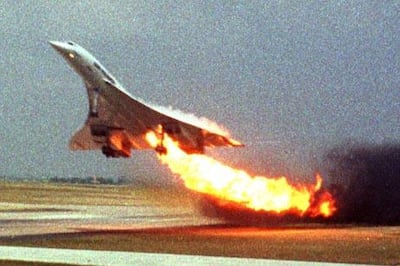
All 13 surviving Concordes were grounded until December 2001, while safety modifications costing millions were carried out. By then, the downturn in passenger numbers resulting from the September 11 terrorist attacks on New York and the Pentagon had finished any hope of a future for Concorde.
With Airbus announcing it could no longer supply maintenance, Air France announced it would take the aircraft out of service in 2003. The surviving Concordes were distributed to museums, their last flights.
Almost within months, plans were being announced for a successor to Concorde. But 20 years later none have carried passengers, or even flown. Despite its glamour and speed, the commercial case for supersonic flight is still weak and the costs of development huge, made worse by the portrayal of aviation emissions as a significant factor in climate change.
The case of Aerion, funded by the Texas billionaire Robert Bass, is instructive. First announced in 2004, its SBJ (Supersonic Business Jet) went through several modifications until the SBJ AS3 in 2021, an aircraft capable of flying four times the speed of sound.
But behind the scenes investors were taking flight. Airbus, Lockheed and General Electric all dropped out. Aerion had nearly 100 potential orders and was building a factory on Florida, but the company collapsed in May 2021, leaving only artist’s impressions.
Several other projects are still, in theory, working away. Russia, whose experience with the Tupolev Tu-144, nicknamed “Concordski”, saw a disastrous crash at the 1973 Paris Air Show, was reported to be considering a second attempt, possibly with Middle East investment.
China may also enter the market, with a rumoured hypersonic jet that could reach five times the speed of sound or 5,633kph.
The most likely successor, though, has a distinctly retro feel. Boom Supersonic, an American company, hopes to fly a one-third scale demonstration aircraft within weeks.
The proposed full-sized model will fly at twice the speed of conventional aircraft from Boeing and Airbus, slightly slower than Concorde, and will offer business-class prices for 65 to 80 passengers.
Due to enter service by the end of the decade, the Boom Overture has several airlines interested enough to take out options to buy, including United with 50, and Japan.
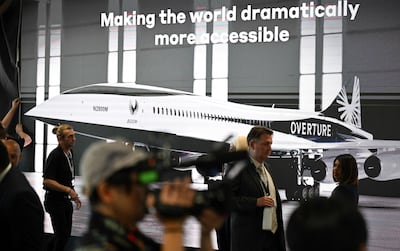
Despite being considerably quieter than its predecessor and more fuel efficient, the Overture will still have sonic boom issues that will, like Concorde, reduce its supersonic use to routes over water. The company also promises that it will be net zero and predicts it will eventually become the standard for long-distance travel.
From the outside, though, its sleek delta wings and needle-like nose resemble the aircraft which first flew in the 1960s. When it comes to supersonic passenger travel, it looks like a case of back to the future. Although this time hopefully with in-flight movies and Wi-Fi.
